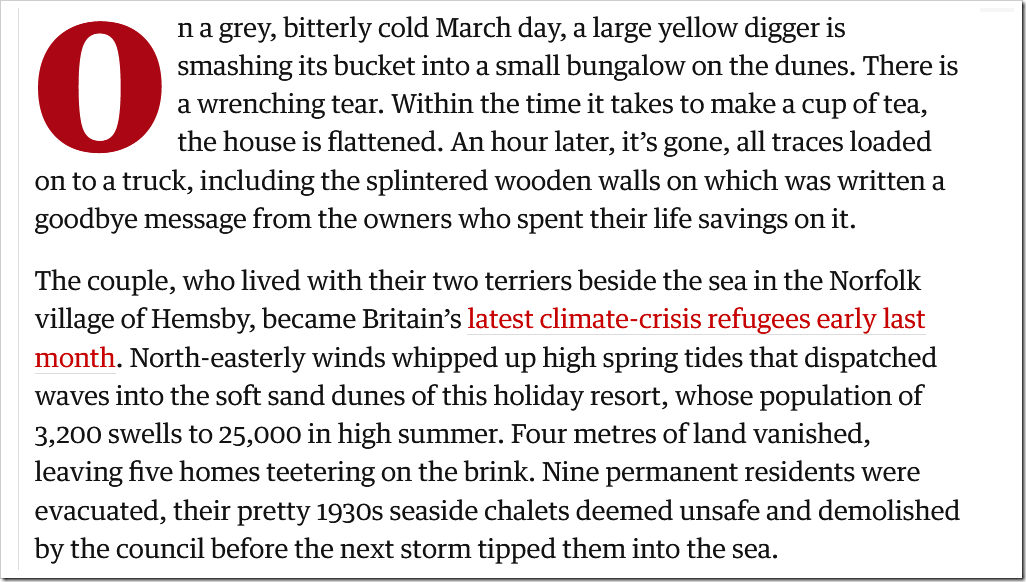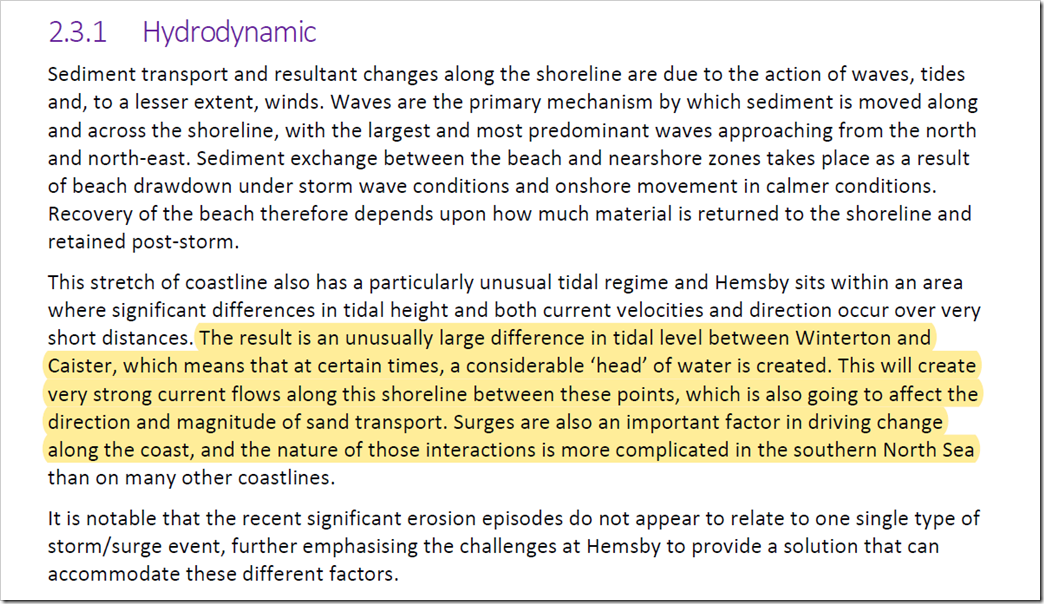Norfolk’s “Climate Refugees”
By Paul Homewood
h/t lloyd jones
Our hopeless media is conflating local erosion problems in Norfolk with absurd forecasts of sea level rise:
Across the country ordinary Britons like Tim Clarke, 56 and Marie Howlett, 41 are facing financial ruin and losing their homes if they can’t find a way to win an impossible and uninsurable battle against the sea.
The couple are some of the last remaining inhabitants of the coastal enclave of Hemsby, Norfolk – a once thriving tourist spot that has now all but been condemned due to the constant coastal erosion that claimed five homes last month alone.
They and other residents of the doomed postcode claim they are fighting both the elements and their local councils, who say they are powerless to stop the process of the erosion.
Tim bought his two-bed detached bungalow for £60,000 eighteen months ago, fulfilling a dream to live by the coast, having moved from Lincolnshire.
The pair live with their daughter Isabella, 10 and their house is now the last one with road access since the March storm which claimed several homes and eight feet of coastline.
Research by climate action group One Home predicts that by 2100, over 2000 properties worth £584million will tumble off cliffs and into the sea with no possible course of action that will avert it.
And if they’re not falling into the sea, a gloomy report published last year by flood expert Paul Sayers suggests they’ll soon be swallowed by it.
According to Climate Change Committee report, nearly 200,000 properties in England may have to be abandoned due to rising sea levels by 2050.
Researchers said the country could face around 14 inches (35cm) of sea level rise compared to historic levels within 30 years and is nearly certain to see close to 3ft (1m) of advancement by the end of the century.
This rate would scrub parts of North Norfolk, Kent and Cornwall off the map.
Meanwhile the ludicrous Guardian goes one stage further, describing Hemsby’s inhabitants as climate-crisis refugees.
As we should all know by now, this same coastal erosion has been taking place in Norfolk for thousands of years; it has nothing to do with climate change, as the BGS Regional Geologist explained just last month:
In fact, as is often the case, matters are much more complex at Hemsby than appear at first sight. Jacobs undertook a study for the local council in 2018:
And it made some interesting points.
For a start, this sort of loss properties is not new, but has been occurring since at least the Second World War. Surprisingly there have also been periods since then of dune growth, as well as decline.
Indeed it appears that the coastline was further inland 200 years ago, since when the dunes have developed on which several houses have been built.
It is of course dunes which help to protect the cliffs.
Another significant factor is the shifting northwards of the Winterton Ness, which is closely connected to the loss of sand on the beach at Hemsby:
Again we find that this movement of the Ness has been occurring for a long time:
And as Jacobs conclude, it is not a simple matter of dune erosion, but the result of a chain reaction of natural movements:
:
The Jacobs study also includes this old map from 1817. Note that there are no houses anywhere near the cliffs. There was a good reason for this!
It was only in the mid 20thC that house building along the cliffs really began:
To top it all though, the Mail and Guardian are attempting to con people that Hemsby is evidence that much of England’s coasts will end up going the same way. The Mail comments:
Research by climate action group One Home predicts that by 2100, over 2000 properties worth £584million will tumble off cliffs and into the sea with no possible course of action that will avert it.
And if they’re not falling into the sea, a gloomy report published last year by flood expert Paul Sayers suggests they’ll soon be swallowed by it.
According to Climate Change Committee report, nearly 200,000 properties in England may have to be abandoned due to rising sea levels by 2050.
Researchers said the country could face around 14 inches (35cm) of sea level rise compared to historic levels within 30 years and is nearly certain to see close to 3ft (1m) of advancement by the end of the century.
In fact the first estimate of 2000 properties is probably about right, and is an insignificant number in the overall view of things. Very few houses from the 1950s are unlikely even to be standing in 2100 anyway.
But claims of 200,000 properties underwater by 2050 are absurd and dishonest, as is the forecast of 35cm of sea level rise within 30 years – the figure for the last 30 years is more like 6cm.
Comments are closed.












As you highlight Paul most of the development has been since the war .A lot of these sorts of seaside communities developed I think this was prior to effective planning rules.Jaywick is similar I believe.
The East Anglian and Lincolnshire coasts have been receding for centuries .
And there are many lost villages and towns due to the cliffs being very soft sands and clays .
Recent erosion has been compounded by the Environment agency changing policy to not protect such locations but enable managed retreat ..So that said
I think the people who paid 60K 5 years ago did not do due diligence .at a minimum.
An old story…
The thriving port town of Dunwich was lost to storms in the 13th Century. But scientists recently have discovered that it wasn’t lost at all – it’s simply underwater.
. . .
Within a square mile just off the shore of modern Dunwich, Sear and his team were able to locate medieval Blackfriars monastery, St Nicholas Church, St Peter’s Church, All Saints, St Katherine’s Chapel and chunks of masonry that could have been the town hall and various port buildings. The mythical lost town of Dunwich was not lost at all, but lying on the seabed – almost exactly where the Tudor map maker and the old storytellers claimed it would be.
https://www.bbc.com/travel/article/20220227-dunwich-the-british-town-lost-to-the-sea
Maybe there was a reason the bungalow was only £60,000. You get a garage for that in my village.
These bungalows, were designed as summer season holiday lets, and not for year round occupation. They have poor insulation, and are prone to damp. I can recall visiting one – in the course of my work – during a bitter winter more than 30 years ago. I was astonished that anyone would want to be living there in those conditions!
Sounds like a good place for the dinghy people.
The refugees won’t have far to travel ….
“A re-survey of the coastline of The Wash carried out by The Ordnance Survey in 2011 revealed that an estimated additional 3,000 acres (12 km2) on its coastline had been created by accretion since previous surveys between 1960 and 1980.”
https://en.wikipedia.org/wiki/The_Wash
I have very happy memories of holidays on the coast between Hemsby and Winterton in the early 1950s – my grandparents owned a bungalow and lived there throughout the summer months. My parents hired another two doors up. The beach was building in those days but eroding further south. A pill box was being undermined at Hemsby gap and I remember a visit to California in 1953 for my parents to view the damage from the storms earlier in the year (my 6-year old self remembers nothing of the damage). My grandparents brought their bungalow when my grandfather retired shortly before the war – by today’s standards it was little more than a glorified shed – a wooden clap board two room structure with an outside loo. The dunes are now eroding and the beach had indeed changed.
Anywhere near the sea is going to have erosion problems irrespective of the actual sea level
Meanwhile across the same North Sea The Netherlands loses nothing, nowt, zilch to the same forces of nature!
Climate emergency, absolute bollocks!
Thanks for the hat tip Paul….did you know that all of Schiphol airport was built on sand dredged from the sea bed near the Norfolk coast?
Schiphol – ship’s grave – and Amsterdam are a lake that is keep dry by pumps, originally driven by windmills. But in the days when the human race progressed, the windmills were replaced by 3 beautiful steam powered pumping stations – 240 windmills per station. Now the pumps are electric.
“…the figure for the last 30 years is more like 6cm.”
And isn’t much of that 6cm the land sinking due to isostatic rebound tilting the British Isles, not rising sea.
Yes, about a third
An excellent article Paul.
We will ignore the thousands of acres reclaimed from the sea no doubt, & sea defences all round Britain that are now farther from the ocean, Glason dock pub and Camber Castle being two. The whole scenario is scaremongering rubbish.
The point of this Mail story escapes me.
But a couple of items amuse me:
‘Tim bought his two-bed detached bungalow for £60,000 eighteen months ago, fulfilling a dream to live by the coast’
I don’t think he bought it – he is renting it from God.
If they get a few years use out of it, it’s not a bad deal.
‘The pair live with their daughter Isabella, 10’
Might she be living with them?